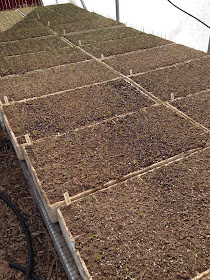My cousin
Paul Crosby – Renaissance man, food artisan and master forager – has been at it
once again. His latest locally sourced,
hand crafted product is Crosby’s Vermont Acorn Vinegar, made in Leicester,
Vermont.
I had always
just assumed that acorns were not edible.
When I express some (slight) skepticism to Paul, he sets me straight.
“People have
been eating acorns forever!” says Paul.
“I’m sure acorns were on the menu at the first Thanksgiving.”
Indeed,
there is a wealth of information available online about foraging and processing
acorns, and quite a history of use, particularly among indigenous populations. Acorns
are high in tannins, a natural substance found in most plant species. Tannins are the source of the slightly bitter
aftertaste found in coffee, tea and wine. But, too much tannin can lead to a tummy ache. In their raw state, acorns can be quite bitter because of the high
levels of tannins, and must be processed before consuming.
Crosby’s
Vermont Acorn Vinegar is bright, bold, and acerbic with a crystalline, amber
color. It’s a strong flavor personality and could overpower more delicate
foods, but would pair nicely with robust, confident flavor profiles. Paul has
made a simple dressing using Vermont Maple Syrup and Crosby’s Vermont Acorn
Vinegar. He’s also mixed maple syrup with the vinegar to make a sweet and tangy
glaze for pork loin or lamb.
 |
| Paul Crosby forages for white oak acorns each autumn |
To produce his Vermont Acorn Vinegar, Paul starts by foraging and he
doesn’t have to stray far from home. “Every fall I gather as many fallen white
oak acorns as I can from my property leaving a few for my furry friends. This
takes hours and last through October. Once collected they are dried and stored
in a cool dry area away from the squirrels. Dried acorns will last over a year
if stored properly.”
Then begins the process of turning acorns into vinegar. “When I get
ready to start a batch I crack up to 2 cups of dried acorns,” says Paul. “I sort out the bad ones and put the
remaining acorns in a bath of hot water to release the bitter tannins. This is
done three times usually to release all the bitterness. I then taste one to
make sure the flavor is right.”
The acorns are now processed and ready to infuse in a gallon of white
vinegar. This usually takes up to three weeks.
“At this point the flavor and color should be nutty and straw
colored,” says Paul. “After three weeks
the vinegar is filtered and put into a pot to boil, and sugar is added to the
batch just like the elderberry vinegar recipe. It's boiled for about 10 minutes,
filtered and then bottled.”
True to the spirit of foraging, nothing gets wasted.
“Now you would think at this point, I would throw the acorns away,”
says Paul. “Wrong! I take them along with a little acorn vinegar
and pickle them with the standard pickling spices. They are aged for up to six
weeks before eating and taste very nice.”
The website
“Eat The Weeds” has a fascinating story on acorn
consumption through the centuries, and reports they are high in nutritional
value. According to the site, a white oak acorn is 50.4 percent carbohydrates,
4.7 percent fat, 4.4 percent protein, and 4.2 percent fiber. A pound of shelled
acorns contains 1,265 calories.
Crosby’s
Vermont Acorn Vinegar is available
for purchase online and sells for $12.00 a bottle. (I received one bottle of Crosby’s Vermont
Acorn Vinegar from Paul to use in preparing this post) A number of Vermont restaurants are also using the vinegar in menu items.
If you
prefer your acorns as lawn art, feast your eyes on the world’s largest acorn
and just imagine the size of the squirrel that would take a bite out of
this!
 |
| Photo Source: Eat the Weeds |
©2014 T.W.
Barritt All Rights Reserved



































